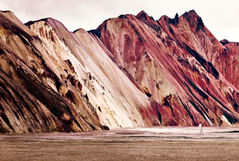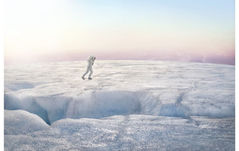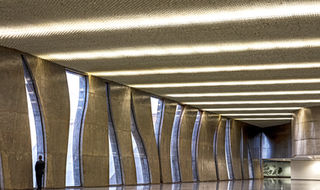Vincent Fournier
SELECTED WORKS
Space Utopia
"In the continuation of my series on the space adventure "Space Utopia" I went to Iceland in August 2021 to photograph the Iceland Moon Mars Simulation expedition. It is a collaboration between the Icelandic Space Agency and Professor Michael Lye with the participation of NASA/Johnson Space Center whose goal is to test a new spacesuit of the Artemis generation: the MS2. The sites for the Iceland Moon Mars Simulation Expedition were selected for their resemblance to an environment similar to that which would be found on the Martian surface and which could serve as landing, research and habitation sites for future planned missions to the Moon and Mars. These sites include lava tunnels, glaciers, glacial debris fields, basal- tic black sands, volcanic craters, and remote areas containing buried ice. Research will determine how astronauts can train to identify signs of Mar- tian life using geothermal energy and explore how frozen water sources in the polar regions of the Moon and Mars can be reused as fuel for rockets and for long-term human habitation.
Iceland has played an important role in the history of space exploration. In the 1960s, NASA sent the Apollo astronauts to northern Iceland to train for their missions to the Moon."
– Vincent Fournier
Space Project
“My work is freely inspired by the dream and mystery side that the scientific and technological utopias echoes in the collective imagination. With the Space Project I have voluntarily mixed a historic and documentary vision of the spatial adventure with staged situations fed by the cinema and my childhood memories. Thus, these mythical places of the space exploration become film sets where Jacques Tati would meet with Jules verne or Stanley Kubrick. This body of work take at present a new resonance with the development of a new space exploration but this time by the private sector of the aerospace and robotics industry.”
“Space exploration is humanity’s great adventure, a leap into the unknown towards a dark light beyond Earth’s protective atmosphere and the gravity that keeps us there. Space represents the universal desire not only to contemplate the sky, but also to project oneself into it. Desire, from the Latin work ‘desiderare’, means regret and ‘nostalgia for a lost star’. But how can one desire something unknown? Could it be that – stardust that we are – we are reminded of a primeval time when we floated in space? Might men not be gods fallen from the sky, unconscious of the fact, but nevertheless nostalgic for the star they have lost?”
“My aesthetic, philosophical, and recreational fascination with outer space undoubtedly comes from the pictures and books I read in the 1970s and 80s – television series, science fiction novels and documentaries – that were blended and superimposed in my memory like a palimpsest. My images are a mix of purely documentary elements and very carefully constructed staging in which each detail depends on the overall composition. Emblematic locations for space exploration are like cinema sets where Tintin might meet Jules Verne in Stanley Kubrick’s 2001: A Space Odyssey…”
“I photographed both the past and the future of space exploration between 2007 and now, from the space race in the 1960s to the NASA SLS launch vehicle expected to go to Mars. The present decade marks the transition from political to economic considerations in space, and the introduction of a worldwide dimension. After the Cold War and the domination of the super powers, the space sector became less of a military priority than an economic one also involving investments by private rms with multiple interests: communication, science, research and development, ecology, health, technology, and even space tourism.”
– Vincent Fournier
Kosmic Memories
‘ “Kosmic Memories” reveals extraordinary architectures, veritable totems of civilisation of the future erected as so many signs of a possible elsewhere. It is not by chance that this science fiction universe was born between the end of the 1960s and the beginning of the 1980s, especially in the satellite and non- aligned countries of the former Russia. First of all, the obsession with the cosmos is an old tropism of the Russian imagination (Tsiolkovsky, Sputnik, Gagarin…) and with the rapprochement of the West, artistic creation frees itself from political dogmas. If all these buildings have different functions, commemorative, political, institutional, their forms testify to the same breath: the invention of a future imbued with science fiction. We can see flying saucers, space stations and a multitude of geometrical shapes from another planet. Built mostly in concrete and at the tops of stellar landscapes, a telluric power from elsewhere emerges from these monumental architectures. Their location, while often a place of memory, also coincides with dawn or dusk, with a lateral light that reinforces their strangeness. Brutalist, futuristic, utopian, mystical, esoteric beauty…between Tintin’s “Temple of the Sun” and the monolith from “2001, Space Odyssey”. These sentinels embody the dream of a future that is always to come.’
– Vincent Fournier
Brasilia
“My interest in the city of Brasilia comes from a mixture of fascination and nostalgia for the stories and representations of the Future. Indeed, the Brazilian capital designed by Oscar Niemeyer and built in 4 years in the middle of a desert, embodies the vision of the future of the 60s. The pilot plan conceived in 1957 by urban planner Lucio Costa coincides with the beginning of the space age and the first artificial satellite of Earth: Sputnik. It is the golden age of the space age, and the city of Brasilia, with its air of a flying saucer that would have landed in the middle of nowhere, shows nostalgia and the dream of a future frozen in time. The case is unique because of its size, an entire city, and its state of conservation: the city’s pilot plan has remained unchanged due to its inscription on the UNESCO World Heritage List. Brasilia, a fossilized modernist temple in a utopian future, is a veritable time capsule.
For this series, I used the city as a setting in which the inhabitants are staged. During my wanderings, different stories came to mind: On Exactitude in Science by Jorge Luis Borges (1946) and this strange empire whose geographical map covers the whole territory, The Desert of the Tartars by Dino Buzzati (1940) and the story of a man who waits all his life for an event that will not happen or the film The Truman Show by Peter Weir (1988) whose hero lives in an illusion. Finally, we must also mention the breathtaking and crazy beauty of the city of Brasilia where absolutely everything is composed with the same writing: linear, precise, minimal, fluid, radical, airy, monumental, musical…”
– Vincent Fournier, 2019.
Post Natural History
“The Post Natural History project shows the archives of an imagined future caught between memory and projection where science, technology and living organisms have all intersected to create a handful of ultra-developed species with highly technological capabilities.”
“Based on conversations with synthetic biology specialists and presented with the aesthetic of encyclopedic boards these “upcoming living species” are familiar yet strange. Indeed, we “know” the rabbit or the lizard, but upon closer inspection, we realize certain differences. For example, the dragonfly possesses a transparent glass belly in which a luminescent sensor measures the rate of pollution.”
“Just like the bestiaries of origin from the Middle Age that were mixing the fantastic with the real, this imaginary archive is a mirror for our hope, fear, and phantasms about the unknown. These surrealistic species are classified by alphabetical order with captions describing their new traits. My inspirations come from old illustrations, painting, poesy, myths and scientific facts.”
– Vincent Fournier
The Man Machine
‘The Man Machine project is a reflection on how artificial creatures such as robots or other avatars can evolve in our day-to-day life. For this speculative fiction series I staged several humanoid robots in realistic reconstructions of usual domestic scenes: at work, at home, in the streets, during leisure… Situations suggest both empathy and detachment towards the robot.
My aim was to create a balance between the spectator and the robot, between a process of identification and distance. We find this idea in the “the Uncanny Valley ” – a scientific theory elaborated by the Japanese roboticist Masahiro Mori which states that the more a robot resembles a human being, the more its imperfections seem monstrous to us. The current development of these artificial creatures in our society brings fascination but also the frightening issue of the social acceptance of these changes.’
– Vincent Fournier
VIDEOS
ABOUT THE ARTIST
Vincent Fournier is a French artist who explores significant mythologies of the future : space exploration, utopian architecture, artificial intelligence, living transformation…
After being awarded a diploma in both sociology and visual arts, he studies at the National School of Photography in Arles and obtains his diploma in 1997. His works can be found in the permanent collections of the Metropolitan Museum of Art (MET) in New York, the Centre Pompidou Paris, the LVMH contemporary Art collection, the Dragonfly Collection in Massignac, the Museum of Fine Arts of Mâcon, Fondation Bullukian in Lyon, the ArtScience Museum in Dublin or the Baccarat Hotel Collection in New-York, among others.
“My work is inspired by the dream and mystery side that the scientific and technological utopias echoes in the collective imagination : space travel, utopian architectures, humanoid robots, the transformation of the living … My interest for these themes comes from the aesthetics they create, the philosophical thrill that they provoke but also their formidable capacity to generate stories, always on the borders of the real and the imaginary. This “in-between” creates a floating that allows different levels of reading and leaves open the interpretation. The stories of the future crystallize so many emotions and questions, at the same time children’s dreams and dreams of civilizations. These are stories that invent a temporality between past, present parallel and future. I use the elements of these stories to create images and objects always put in tension by oppositions that come to disturb our eyes and blur the borders: reality / fiction, science / belief, past / future, visible / invisible, natural / artificial … I believe that the starting point of this “obsession” comes from my childhood and many visits to the Palais de la Découverte in Paris with my grandmother. All these evocations of the “wonder of science” and the mysteries of the Universe have nourished my imagination and stimulated my curiosity for utopias and the field of possibilities. I also grew up in the ’70s and ’80s when the year 2000 was like a huge mountain, at the top of which were flying cars. This projection did not happen, at least not so visibly, but it is I think what made me want to extend these dreams of children.”
– Vincent Fournier, February 2019.































































































